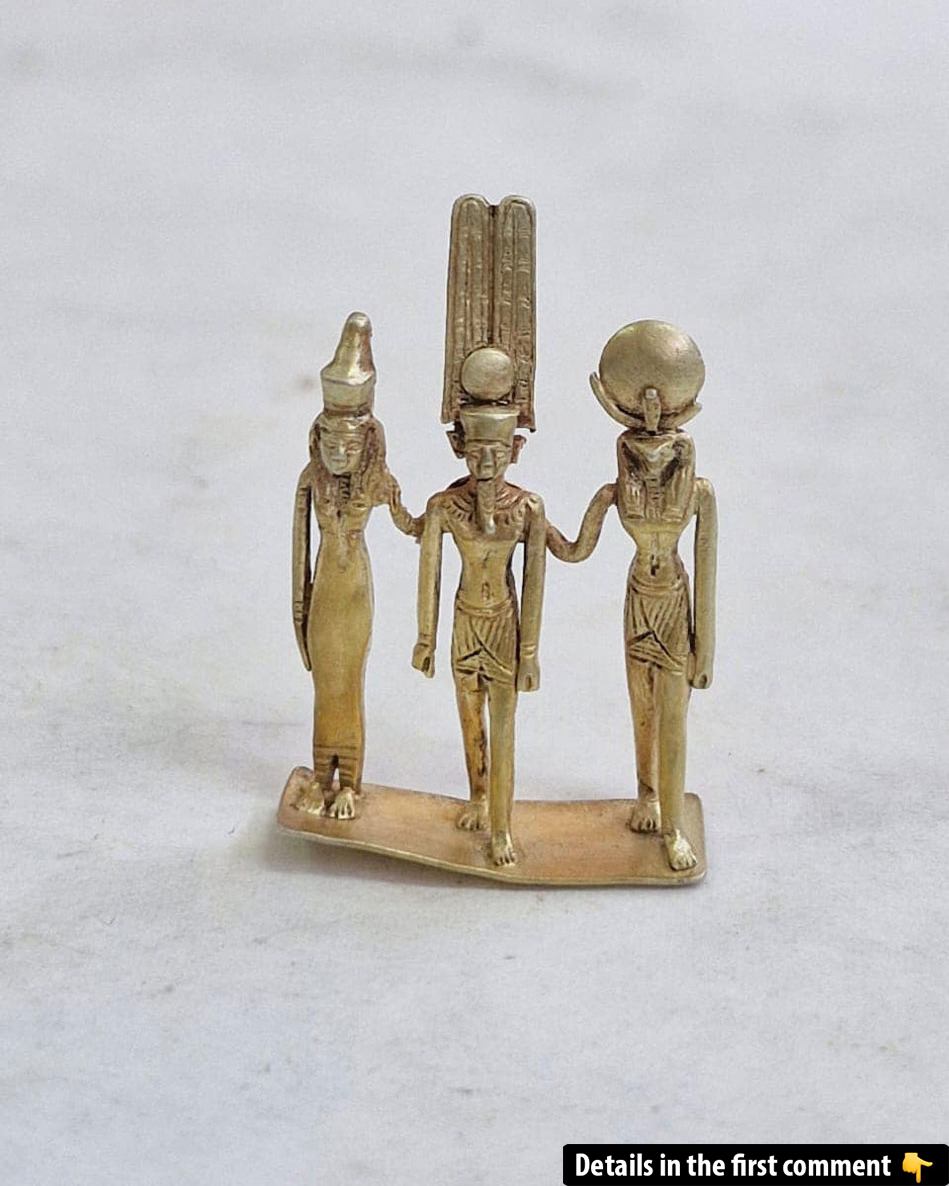The vast, towering remains of the Karnak Temple Complex in Luxor, Egypt, have long been a window into the grandeur of ancient Egyptian civilization. But in a recent discovery, archaeologists have unearthed a collection of gold jewelry that not only illuminates the artistic achievements of the period but also offers a deeper glimpse into the religious practices of the time. The discovery of this 26th Dynasty treasure, found in a well-preserved ceramic vessel, underscores the rich cultural heritage of Egypt, even during a time of political decline. This find reveals new insights into the craftsmanship and symbolism that defined ancient Egypt, offering a rare glimpse into the artistic and spiritual worlds of the time.
The Karnak Temple Complex: A Historical Overview
Karnak Temple, one of Egypt’s most significant religious sites, has always been a center of power and worship. Located in Luxor, the ancient capital of Thebes, it was dedicated primarily to the god Amun-Ra, the sun god. The complex has evolved over millennia, with rulers from the Middle Kingdom through to the 20th Dynasty contributing to its growth. Famous pharaohs such as Thutmose III, Hatshepsut, Ramses III, and many others left their mark on the temple complex, adding monumental structures, halls, and shrines that testified to their power and devotion.
However, the construction of the temple complex slowed dramatically with the onset of the 20th Dynasty and the decline of Egypt’s political might. By the time of the 26th Dynasty, the country’s former splendor had waned, and the temple’s grandeur was beginning to diminish. During the Christian era, parts of the temple were repurposed, and much of its original purpose was lost. Though rediscovered in the 16th century, much of the temple was left in ruins, with archaeologists and historians alike left to ponder its secrets.
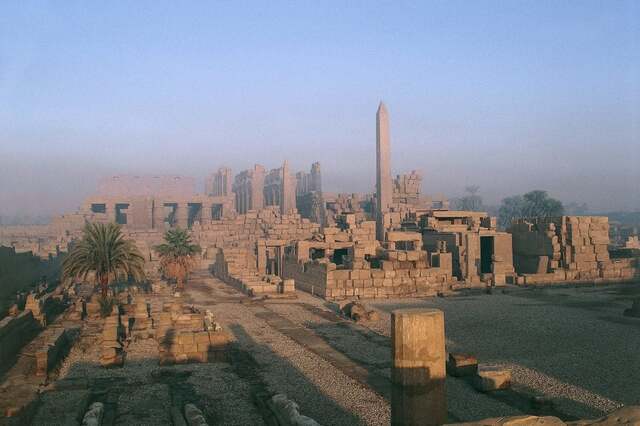
Video
Watch the video to see rare ancient Egyptian gold artifacts discovered at Karnak Temple! Don’t miss this incredible archaeological find and its historical significance.
The Discovery of Gold Jewelry and Artifacts
In a partnership between the French-Egyptian Centre for the Study of the Temples of Karnak, the French National Centre for Scientific Research, and Egypt’s Supreme Council of Antiquities, researchers were surveying the northwest sector of the temple complex when they uncovered something remarkable. A partially broken ceramic vessel, nestled deep within the temple precinct, contained gold jewelry that had lain hidden for over two millennia.

The artifacts, dated to the 26th Dynasty (664–525 BCE), included an array of gold rings, amulets, a necklace strung with gold-plated beads, and a finely crafted brooch. This collection, while small in size, represents an invaluable look into the jewelry and ornamentation of the period. The well-preserved state of the objects is a testament to the craftsmanship of ancient Egyptian artisans, who used gold to create not only beautiful adornments but also sacred symbols.
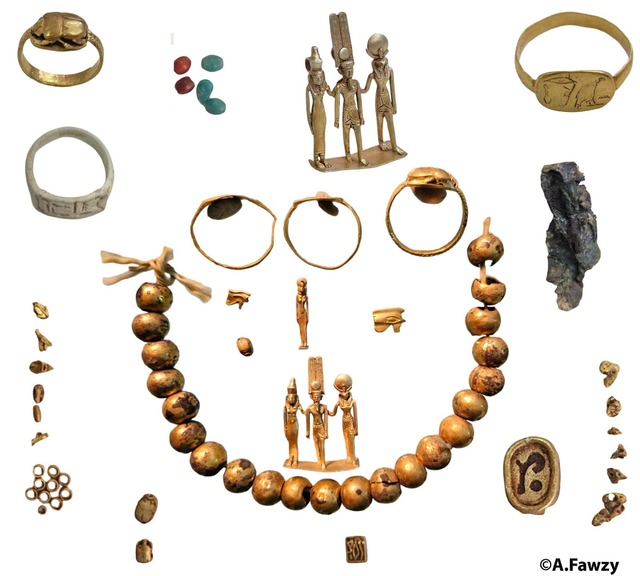
The Importance of the Findings: Understanding Karnak’s Development
The gold jewelry and ornaments are an important find, as they shed light on the cultural and historical development of the Karnak temple complex during a period of political transition. Despite the waning power of Egypt’s rulers in this era, artisans still looked to Egypt’s ancient traditions for inspiration. The items reflect a deep reverence for Egypt’s religious heritage and convey a sense of continuity with the past.
Mohammed Ismail Khaled of the Egyptian Antiquities Council noted that the discovery provides valuable insight into the historical evolution of Karnak’s religious structures. The artifacts help to fill in gaps in the understanding of the temple’s development during the 26th Dynasty, when it was governed by the Saite kings. These kings, though ruling in a time of decline, still sought to maintain Egypt’s ancient traditions, as seen in their elaborate artistic creations.
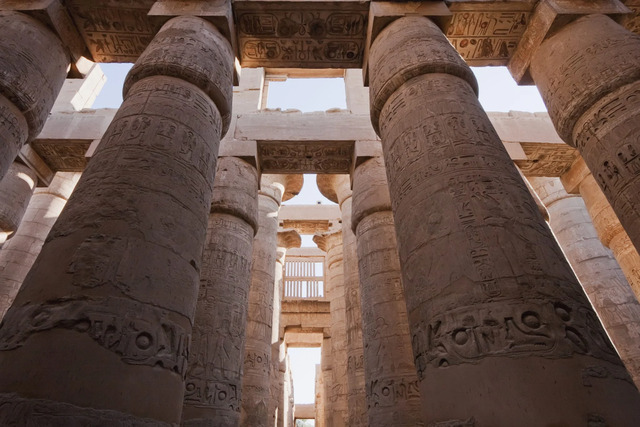
The Art and Symbolism of the Gold Jewelry
Among the most striking pieces of the discovery is the collection of gold rings and amulets, each with intricate carvings and symbols. These items, while decorative, served a greater purpose in ancient Egyptian society. Rings and amulets were often worn as symbols of protection, power, and divine favor. Many of these pieces would have been worn by priests, nobles, or temple officials, linking the wearer to the divine world.
The brooch, in particular, stands out for its detailed craftsmanship. This piece, like many others, was carved with representations of deities and symbols tied to Egypt’s religious beliefs. The jewelry’s designs reflect both the personal and spiritual significance of these objects, as they were believed to carry protective powers and assist the wearer in their journey to the afterlife.
A Statuette of Amun, Mut, and Khonsu: A Symbolic Representation
One of the most fascinating discoveries among the artifacts is a statuette depicting the Theban triad—Amun, his wife Mut, and their son Khonsu. The statuette, crafted with care and attention to detail, portrays these deities in full regalia, further emphasizing the sacredness of the items found in the temple precinct. Amun, Mut, and Khonsu were central figures in the Theban pantheon, and their representation in this piece highlights the continued importance of religious practices during a time when Egypt was losing its political dominance.
This sculpture’s symbolic significance cannot be overstated. The Theban triad was worshipped for centuries in the Karnak Temple, and the presence of this statuette in such a prominent location underscores the ongoing reverence for these gods even during Egypt’s later dynasties. The craftsmanship of the piece also reflects the skilled artisans who worked during this period, drawing from Egypt’s long-standing artistic traditions.
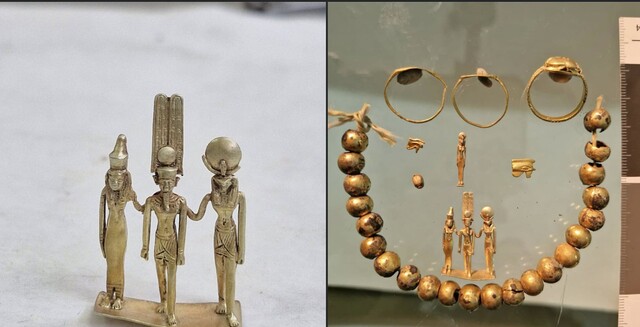
Mudbrick Buildings: Workshops and Storage Areas
Along with the jewelry and religious artifacts, researchers also discovered mudbrick buildings at the site, which they believe were used for storage or workshops during the construction of the temple. These mudbrick structures, typical of ancient Egyptian construction, offer further insight into the everyday life of those who worked in the temple. These buildings likely housed the artisans, laborers, and temple officials responsible for the temple’s upkeep and religious functions.
The presence of these buildings also highlights the complexity of temple construction during the 26th Dynasty. Despite the decline in political power, the temple complex continued to function as a center of religious and social activity, with a dedicated workforce contributing to its maintenance and growth.
Restoration and Future Exhibitions
The newly uncovered artifacts are currently undergoing study and restoration, with plans for them to be displayed at the Luxor Museum. These pieces, once fully restored, will offer visitors a tangible connection to ancient Egypt’s religious and artistic past. The Luxor Museum, which already houses several artifacts from the Karnak Temple complex, will serve as the perfect venue for showcasing these important discoveries.
The ongoing restoration of these items will help preserve them for future generations, allowing scholars and visitors alike to continue studying the intricacies of ancient Egyptian craftsmanship. These artifacts will also provide a deeper understanding of the cultural and religious practices that shaped the history of Karnak and Egypt as a whole.
Video
Watch the video to uncover the weird secrets discovered by archaeologists in ancient Egypt’s temples! Don’t miss these fascinating revelations from Egypt’s mysterious past.
Conclusion: What This Discovery Reveals About Ancient Egypt
The discovery of the gold jewelry and religious artifacts at the Karnak Temple is a significant moment in the study of ancient Egypt. It provides a window into the lives of those who lived and worshipped in the temple during the 26th Dynasty, offering a glimpse into their religious practices, artistic achievements, and social organization. The items found—ranging from ornate jewelry to the symbolic statuette of the Theban triad—serve as a testament to Egypt’s enduring cultural legacy, even in times of political decline.
As the artifacts undergo further study and restoration, they will undoubtedly offer even more insights into the rich history of Karnak and the broader world of ancient Egypt. This discovery not only deepens our understanding of the past but also reminds us of the timeless nature of human creativity and spiritual devotion. The gold jewelry and religious symbols unearthed in Karnak stand as enduring symbols of Egypt’s glory and its ability to inspire awe, even thousands of years later.
